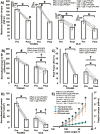Submaximal Eccentric Training During Immobilization Does Not Prevent Serial Sarcomere Loss or Impairments in Mechanical Function in Old or Young Rats
- PMID: 40237382
- PMCID: PMC12217513
- DOI: 10.1093/gerona/glaf082
Submaximal Eccentric Training During Immobilization Does Not Prevent Serial Sarcomere Loss or Impairments in Mechanical Function in Old or Young Rats
Abstract
The age-related loss of muscle mass is partly driven by a reduction in serial sarcomere number (SSN), and further SSN loss occurs during immobilization. Serial sarcomere number is associated with optimal force and power production and muscle passive tension, thus immobilization-induced SSN loss is especially a concern for older individuals who are often subjected to forced muscle disuse with illness and injury. We previously showed that submaximal eccentric resistance training increased SSN and improved muscle function in old rats. The present study investigated whether this training could prevent the losses of SSN and function when performed intermittently during immobilization. Ten old (32 months) and 10 young (8 months) rats underwent unilateral casting of the plantar flexors in a shortened position for 2 weeks. Thrice weekly, casts were removed for isokinetic eccentric resistance training. Pre- and post-training we assessed in-vivo maximum isometric torque at ankle angles corresponding to stretched and neutral muscle lengths, the passive torque-angle relationship, and isotonic power. The soleus and medial gastrocnemius were harvested for SSN measurements, with the untrained leg as a control. In old and young rats, muscles of the casted leg had smaller muscle wet weights (- 20%-40%), physiological cross-sectional area (- 16%-20%), and SSN (- 7%-29%) than the control leg. Furthermore, maximum isometric torque (- 37%-46%) and isotonic power (-≈70%) decreased, and passive torque increased (+≈400%) from pre- to post-training for both age groups. Thus, irrespective of age, submaximal eccentric resistance training 3 days/week was ineffective for preventing the losses of muscle contractile tissue and mechanical function during casting.
Keywords: Aging; Casting; Force–length relationship; Passive force; Power; Sarcomerogenesis.
© The Author(s) 2025. Published by Oxford University Press on behalf of the Gerontological Society of America.
Conflict of interest statement
None.
Figures





Similar articles
-
Submaximal eccentric resistance training increases serial sarcomere number and improves dynamic muscle performance in old rats.Physiol Rep. 2024 Oct;12(19):e70036. doi: 10.14814/phy2.70036. Physiol Rep. 2024. PMID: 39362825 Free PMC article.
-
Age-related blunting of serial sarcomerogenesis and mechanical adaptations following 4 wk of maximal eccentric resistance training.J Appl Physiol (1985). 2024 May 1;136(5):1209-1225. doi: 10.1152/japplphysiol.00041.2024. Epub 2024 Mar 21. J Appl Physiol (1985). 2024. PMID: 38511212
-
Changes in serial sarcomere number of five hindlimb muscles across adult aging in rats.Gerontology. 2025 Jun 22:1-23. doi: 10.1159/000546887. Online ahead of print. Gerontology. 2025. PMID: 40562020
-
Triggering sarcomerogenesis: Examining key stimuli and the role attributed to eccentric training-Historical, systematic, and meta-analytic review.J Sport Health Sci. 2025 Jul 5:101073. doi: 10.1016/j.jshs.2025.101073. Online ahead of print. J Sport Health Sci. 2025. PMID: 40623648 Review.
-
Physical exercise training interventions for children and young adults during and after treatment for childhood cancer.Cochrane Database Syst Rev. 2016 Mar 31;3(3):CD008796. doi: 10.1002/14651858.CD008796.pub3. Cochrane Database Syst Rev. 2016. PMID: 27030386 Free PMC article.
References
-
- Narici MV, Maffulli N.. Sarcopenia: characteristics, mechanisms and functional significance. Br Med Bull. 2010;95(1):139–159. https://doi.org/ 10.1093/bmb/ldq008 - DOI - PubMed
-
- Hinks A, Hawke TJ, Franchi MV, Power GA.. The importance of serial sarcomere addition for muscle function and the impact of aging. J Appl Physiol (Bethesda, Md.: 1985). 2023;135(2):375–393. https://doi.org/ 10.1152/japplphysiol.00205.2023 - DOI - PubMed
-
- Hooper AC. Length, diameter and number of ageing skeletal muscle fibres. Gerontology. 1981;27(3):121–126. https://doi.org/ 10.1159/000212459 - DOI - PubMed
-
- Power GA, Crooks S, Fletcher JR, Macintosh BR, Herzog W.. Age-related reductions in the number of serial sarcomeres contribute to shorter fascicle lengths but not elevated passive tension. J Exp Biol. 2021;224(10):jeb242172. https://doi.org/ 10.1242/jeb.242172 - DOI - PubMed
-
- Hinks A, Patterson MA, Njai BS, Power GA.. Age-related blunting of serial sarcomerogenesis and mechanical adaptations following 4 weeks of maximal eccentric resistance training. J Appl Physiol. 2024;136(5):1209–1225. https://doi.org/ 10.1152/japplphysiol.00041.2024 - DOI - PubMed
MeSH terms
Grants and funding
LinkOut - more resources
Full Text Sources
Medical

